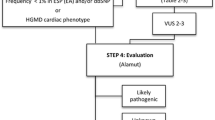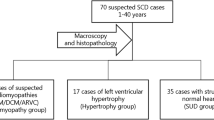Abstract
To determine variations in the SCN5A gene linked to inherited cardiac arrhythmogenic disorders in sudden, unexplained infant death (SUID) cases examined at the Pretoria Medico-Legal Laboratory, South Africa. A retrospective study was conducted on SUID cases and controls, analyzing DNA extracted from archived formalin-fixed, paraffin-embedded (FFPE) myocardial tissue samples as well as blood samples. A total of 48 FFPE tissue samples (cases), 10 control FFPE tissue samples and nine control blood samples were included. DNA extracted from all samples was used to test for variations in the SCN5A gene by using high resolution melt (HRM) real-time PCR and sequencing. Genetic analysis showed 31 different single nucleotide variants in the entire study population (n = 67). Five previously reported variants of known pathogenic significance, and 14 variants of benign clinical significance, were identified. The study found 12 different variants in the cases that were not published in any database or literature and were considered novel. Of these novel variants, two were predicted as “probably damaging” with a high level of certainty (found in four case samples), one (identified in another case sample) was predicted to be “possibly damaging” with a 50% chance of being disease-causing, and nine were predicted to be benign. This study shows the significant added value of using genetic testing in determining the cause of death in South African SUID cases. Considering the high heritability of these arrhythmic disorders, post mortem genetic testing could play an important role in the understanding of the pathogenesis thereof and could also aid in the diagnosis and treatment of family members at risk, ultimately preventing similar future cases.
Similar content being viewed by others
References
Doolan A, Langlois N, Chiu C, et al. Postmortem molecular analysis of KCNQ1 and SCN5A genes in sudden unexplained death in young Australians. Int J Cardiol. 2008;127:138–41.
Carroll R, Wood JN. Sudden unexpected infant death: a compassionate forensic approach to care. Clin Pediatr Emerg Med. 2012;13:239–48.
Neubauer J, Lecca MR, Russo G, et al. Post-mortem whole-exome analysis in a large sudden infant death syndrome cohort with a focus on cardiovascular and metabolic genetic diseases. Eur J Hum Genet. 2017;25:404–9.
Centers for Disease Control and Prevention. Sudden unexpected infant death and sudden infant death syndrome. 2016. www.cdc.gov/sids/data.htm. Accessed 8 April 2016.
Wang D, Shah KR, Yon Um S, et al. Cardiac channelopathy testing in 274 ethnically diverse sudden unexplained deaths. Forensic Sci Int. 2014;237:90–9.
du Toit-Prinsloo L, Dempers J, Verster J, et al. Toward a standardized investigation protocol in sudden unexpected deaths in infancy in South Africa: a multicenter study of medico-legal investigation procedures and outcomes. Forensic Sci Med Pathol. 2013;9:344–50.
Opdal SH, Rognum TO. Gene variants predisposing to SIDS: current knowledge. Forensic Sci Med Pathol. 2011;7:26–36.
Moon RY. Task force on sudden infant death syndrome. SIDS and other sleep-related infant deaths: expansion of recommendations for a safe infant sleeping environment. Pediatrics. 2011;128:1030–9.
Krous HF, Beckwith JB, Byard RW, et al. Sudden infant death syndrome and unclassified sudden infant deaths: a definitional and diagnostic approach. Pediatrics. 2004;114:234–8.
Byard RW. Changing infant death rates: diagnostic shift, success story, or both? Forensic Sci Med Pathol. 2013;9:1–2.
Pasquale-Styles MA, Tackitt PL, Schmidt CJ. Infant death scene investigation and the assessment of potential risk factors for asphyxia: a review of 209 sudden unexpected infant deaths. J Forensic Sci. 2007;52:924–9.
Dempers JJ, Coldrey J, Burger EH, et al. The institution of a standardized investigation protocol for sudden infant death in the Eastern Metropole, Cape Town, South Africa. J Forensic Sci. 2016;61:1508–14.
Byard RW. SUDI or “undetermined”: does it matter? Forensic Sci Med Pathol. 2009;5:252–3.
Byard RW. Possible mechanisms responsible for the sudden infant death syndrome. J Paediatr Child Health. 1991;27:147–57.
Arnestad M, Crotti L, Rognum TO, et al. Prevalence of long-QT syndrome gene variants in sudden infant death syndrome. Circulation. 2007;115:361–70.
Evans A, Bagnall RD, Duflou J, et al. Postmortem review and genetic analysis in sudden infant death syndrome: an 11-year review. Hum Pathol. 2013;44:1730–6.
Byard RW. Sudden pediatric death: issues and overview. In: Byard RW, editor. Sudden death in the young. 3rd ed. New York: Cambridge University Press; 2010. p. 1–2.
Glengarry JM, Crawford J, Morrow PL, et al. Long QT molecular autopsy in sudden infant death syndrome. Arch Dis Child. 2014;99:635–40.
Kibel MA, Molteno CD, de Decker R. Cot death controversies. SAMJ. 2005;95:853–7.
Filiano JJ, Kinney HC. A perspective on neuropathologic findings in victims of the sudden infant death syndrome: the triple-risk model. Biol Neonate. 1994;65:194–7.
Kinney HC, Thach BT. The sudden infant death syndrome. N Engl J Med. 2009;361:795–805.
Garcia AJ, Koschnitzky JE, Ramirez J. The physiological determinants of sudden infant death syndrome. Respir Physiol Neurobiol. 2013;189:288–300.
Deo R, Albert CM. Epidemiology and genetics of sudden cardiac death. Circulation. 2012;125:620–37.
Stattin E, Westin IM, Cederquist K, et al. Genetic screening in sudden cardiac death in the young can save future lives. Int J Legal Med. 2016;130:59–66.
Crotti L, Kotta MC. The role of genetics in primary ventricular fibrillation, inherited channelopathies and cardiomyopathies. Int J Cardiol. 2017;237:45–8.
Abriel H, Zaklyazminskaya EV. Cardiac channelopathies: genetic and molecular mechanisms. Gene. 2013;517:1–11.
Schwartz PJ, Ackerman MJ, George AL, et al. Impact of genetics on the clinical management of channelopathies. J Am Coll Cardiol. 2013;62:169–80.
Wilders R. Cardiac ion channelopathies and the sudden infant death syndrome. ISRN Cardiol. 2012;2012:846171.
Semsarian C, Ingles J, Wilde AAM. Sudden cardiac death in the young: the molecular autopsy and a practical approach to surviving relatives. Eur Heart J. 2015;36:1290–6.
Monteforte N, Napolitano C, Priori SG. Genetics and arrhythmias: diagnostic and prognostic applications. Rev Esp Cardiol. 2012;65:278–86.
Ackerman MJ, Marcou CA, Tester DJ. Personalized medicine: genetic diagnosis for inherited cardiomyopathies/channelopathies. Rev Esp Cardiol. 2013;66:298–307.
George AL. Inherited disorders of voltage-gated sodium channels. J Clin Investig. 2005;115:1990–9.
Chugh SS, Reinier K, Teodorescu C, et al. Epidemiology of sudden cardiac death: clinical and research implications. Prog Cardiovasc Dis. 2008;51:213–28.
Wang S, Li L, Tao R, et al. Ion channelopathies associated genetic variants as the culprit for sudden unexplained death. Forensic Sci Int. 2017;275:128–37.
Millat G, Chevalier P, Restier-Milon L, et al. Spectrum of pathogenic mutations and associated polymorphisms in a cohort of 44 unrelated patients with long QT syndrome. Clin Genet. 2006;70:214–27.
Atlas of cardiac genetic variation. SCN5A: c.302C > T. 2016. https://cardiobd.org/ACGV/acgv_variant.php?.id=116354. Accessed 21 Sept 2017.
Takahata T, Yasui-Furukori N, Sasaki S, et al. Nucleotide changes in the translated region of SCN5A from Japanese patients with Brugada syndrome and control subjects. Life Sci. 2003;72:2391–9.
Daimi H, Khelil AH, Hamda KB, et al. Absence of family history and phenotype-genotype correlation in pediatric Brugada syndrome: more burden to bear in clinical and genetic diagnostics. Pediatr Cardiol. 2015;36:1090–6.
Kiehne N, Kauferstein S. Mutations in the SCN5A gene: evidence for a link between long QT syndrome and sudden death? Forensic Sci Int Genet. 2007;1:170–4.
Park HS, Kim YN, Lee YS, et al. Genetic analysis of SCN5A in Korean patients associated with atrioventricular conduction block. Genomic Inform. 2012;10:110–6.
Noseworthy PA, Newton-Cheh C. Genetic determinants of sudden cardiac death. Circulation. 2008;118:1854–63.
Splawski I, Timothy KW, Tateyama M, et al. Variant of SCN5A sodium channel implicated in risk of cardiac arrhythmia. Science. 2002;297:1333–6.
Plant LD, Bowers PN, Liu Q, et al. A common cardiac sodium channel variant associated with sudden infant death in African Americans, SCN5A S1103Y. J Clin Investig. 2006;116:430–5.
Zydlewski AW, Hasbargen JA. Hypothermia-induced hypokalemia. Mil Med. 1998;163:719–21.
National Center of Biotechnology and Information. NM_198056.2 (SCN5A): 1993G > A (p.Ala665Thr). 2017. https://www.ncbi.nlm.nih.gov.clinvar/variation/201579/summary-evidence. Accessed 21 Sept 2017.
Makita N, Seki A, Sumitomo N, et al. A connexin 40 mutation associated with a malignant variant of progressive familial heart block type-1. Circ Arrhythm Electrophysiol. 2012;5:163–72.
Sayeed Z, Salam A, Haque Z, et al. Brugada syndrome with a novel missense mutation in SCN5A gene: a case report from Bangladesh. Indian Heart J. 2014;66:104–7.
Shim SH, Ito M, Maher T, et al. Gene sequencing in neonates and infants with the long QT syndrome. Genet Test. 2005;9:281–4.
Uzieblo-Zyczkowska B, Gielerak G, Siedlecki P, et al. Genetic diversity of SCN5A gene and its possible association with the concealed form of Brugada syndrome development in Polish group of patients. Bio Med Res Int. 2014;2014:462609.
Hertz CL, Christiansen SL, Ferrero-Miliani L, et al. Next-generation sequencing of 100 candidate genes in young victims of suspected sudden cardiac death with structural abnormalities of the heart. Int J Legal Med. 2016;130:91–102.
Veerman CC, Wilde AAM, Lodder EM. The cardiac sodium channel gene SCN5A and its gene product Nav1.5: role in physiology and pathophysiology. Gene. 2015;573:177–87.
Skinner JR. Is there a relation between SIDS and long QT syndrome? Arch Dis Child. 2005;90:445–9.
Otagiri T, Kijima K, Osawa M, et al. Cardiac ion channel gene mutations in sudden infant death syndrome. Pediatr Res. 2008;64:482–7.
Millat G, Kugener B, Chevalier P, et al. Contribution of long-QT syndrome genetic variants in sudden infant death syndrome. Pediatr Cardiol. 2009;30:502–9.
Tester DJ, Ackerman MJ. Postmortem long QT syndrome genetic testing for sudden unexplained death in the young. J Am Coll Cardiol. 2007;49:240–6.
Campuzano O, Sanchez-Molero O, Allegue C, et al. Post-mortem genetic analysis in juvenile cases of sudden cardiac death. Forensic Sci Int. 2014;245:30–7.
Clatot J, Ziyadeh-Isleem S, Maugenre S, et al. Dominant-negative effect of SCN5A N-terminal mutations through the interaction of Nav1.5 α-subunits. Cardiovasc Res. 2012;96:53–63.
Kubus P, Janousek J. Sudden cardiac death in children and young adults - epidemiology and prevention. Cor et Vasa. 2012;54:223–6.
Giudicessi JR, Ackerman MJ. Determinants of incomplete penetrance and variable expressivity in heritable cardiac arrhythmic syndromes. Transl Res. 2013;161:1–14.
Mensah GA, Peprah EK, Sampson UKA, et al. H3 Africa comes of age. CVJ Africa. 2015;26:5–7.
Funding
The authors would like to thank the Genomic Research Institute from the University of Pretoria, South Africa, for funding the research.
Author information
Authors and Affiliations
Corresponding author
Ethics declarations
Ethics approval for this study was obtained from the Faculty of Health Sciences Research Ethics Committee, University of Pretoria (UP) (142/2014).
Conflict of interest
The authors declare that there is no conflict of interest.
Rights and permissions
About this article
Cite this article
van Deventer, B.S., du Toit-Prinsloo, L. & van Niekerk, C. Feasibility of analysis of the SCN5A gene in paraffin embedded samples in sudden infant death cases at the Pretoria Medico-Legal Laboratory, South Africa. Forensic Sci Med Pathol 14, 276–284 (2018). https://doi.org/10.1007/s12024-018-9995-5
Accepted:
Published:
Issue Date:
DOI: https://doi.org/10.1007/s12024-018-9995-5




